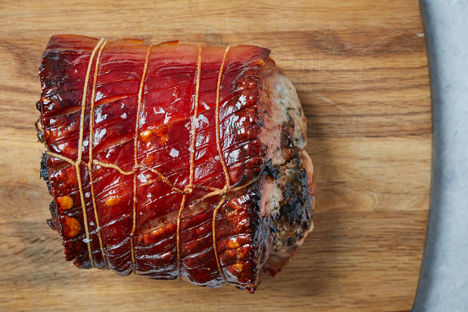Pork loin is one of the more premium cuts of pork. Taken from the back, just above the ribs, this section of the pig contains no fat or muscle, resulting in a very lean, tender cut. Due to its lack of fat, the loin can be at risk of drying out so it is commonly sold as a skin-on roasting joint, which gives it a protective layer of fat, or sometimes on the bone (as a rack of pork), which also helps keep the meat succulent.
What’s the difference between pork loin and pork tenderloin?
Pork loin is not to be confused with the tenderloin (also known as the pork fillet). Whilst both are long, lean cuts, the tenderloin is much smaller and is a muscle which runs alongside the spine. While the loin suits a low, slow roast or braise to prevent it drying out, due to its size, the tenderloin is best quickly grilled, roasted or pan-fried to keep it juicy.
What to look for when buying pork loin
As with all meat, we recommend buying free-range where possible and the highest quality you can afford, as it really does make a huge difference to the final flavour (as well as the obvious ethical and environmental reasons). Rare breeds such as Tamworth and Gloucester Old Spot are always worth keeping an eye out for as well as the famous Iberico pork from Spain or the rarer but seriously good Mangalitza. When selecting your loin, the meat should be a fresh pink colour, and should not be turning a grey hue which would indicate it's older. A 1.5kg boneless joint will feed 4-6 people.
How to brine pork loin
As previously mentioned, pork loin is a lean meat prone to drying out. Brining is an excellent way to help you avoid this, particular if cooking using a dry heat such as roasting or barbecuing. When submerged in a brine, the salt in the solution means the meat not only absorbs some of the extra water but also retains it whilst cooking, resulting in a juicier texture. Not only this, but brining ensures a well seasoned meat all the way through, which is handy for thicker cuts like the loin that otherwise would only be seasoned around the edges. Have a read through our brining guide below to learn everything you need to know, or if you have sous vide equipment, find out how to use it to ensure seriously moist pork loin every single time.
How to cook pork loin
Not sure where to start? Follow our simple method for cooking a pork loin joint here. Feel free to switch up the herbs and spices to whatever you feel like
Metric
Imperial
- 1 pork loin, weighing approx. 1kg
- 4 sprigs of thyme, leaves picked
- 2 garlic cloves, grated
- 1 lemon, zested
- 1 tsp flaky sea salt
- 1/4 tsp freshly ground black pepper
- 30ml of olive oil
Preheat an oven to 200°C fan/gas mark 6. Score the skin in 1cm intervals, ensuring you don't pierce the meat underneath (this helps the skin to crisp up and turn into crackling)
Pound the garlic cloves, lemon zest and thyme leaves in a pestle and mortar until you have a paste. Add 30ml olive oil with salt and pepper. Rub this all over the pork loin flesh, avoiding the skin. It is important to keep the skin dry for optimum crackling
Bake in the oven for 50-60 minutes, then leave to rest for at least 10 minutes before carving
Different types of pork loin and recipe inspiration
Rack of pork
Pork loin can come in several different formats, each with different benefits. A rack of pork is the loin with part of the ribs attached. Cooking on the bone creates a bit of a barrier between the heat source and the meat which helps keep the meat succulent, plus it is said meat next to the bone is tastier too.
Pork chops
Pork escalopes
Pork escalopes, or medallions (though these are usually cut from the tenderloin) are round slices of the loin with no skin, fat or bone attached, making them an incredibly lean cut. But as a result, they are very prone to drying out, so are best cooked quickly and in a sauce. They are also well suited to a schnitzel style of cookery, which sees the lean steaks coated in breadcrumbs that seal in the moisture when cooking. See above for our best recipes when working with escalopes.
Boneless pork loin
A boneless pork loin is a popular choice for a roast dinner. The cut comes skin-on for excellent crackling potential and the layer of fat below it keeps the meat juicy and adds flavour.
Skinless and boneless pork loin
If you want to avoid the skin and fat, the lean loin itself is best marinated and cooked with plenty of liquid so that it steams as well as roasts and you’re not losing too much moisture. The recipes above are two very different but equally delicious examples of this. You could also consider stuffing the loin, by butterflying the meat out until flat, spreading over a stuffing or flavourful paste (gochujang, roasted garlic, miso or harissa are some of our favourites) then rolling back up and tying with butcher's string.
Stuffed pork loin
Pork loin the Italian way
Wonderful Wellingtons
Wrapping the loin in pastry is a fantastic way of sealing in moisture, as well as being absolutely delicious. Treat yourself with these recipes for both loin and tenderloin Wellingtons below.
Get in touch
Please sign in or register to send a comment to Great British Chefs.


